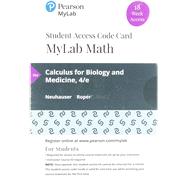Calculus for Biology and Medicine shows how calculus is used to analyze phenomena in nature. The text motivates life and health science majors to learn calculus through relevant and strategically placed applications to their chosen fields.

MyLab Math with Pearson eText -- 18 Week Standalone Access Card -- for Calculus for Biology and Medicine
by Neuhauser, ClaudiaRent Textbook
Buy Courseware
New Textbook
We're Sorry
Sold Out
Used Textbook
We're Sorry
Sold Out
How Marketplace Works:
- This item is offered by an independent seller and not shipped from our warehouse
- Item details like edition and cover design may differ from our description; see seller's comments before ordering.
- Sellers much confirm and ship within two business days; otherwise, the order will be cancelled and refunded.
- Marketplace purchases cannot be returned to eCampus.com. Contact the seller directly for inquiries; if no response within two days, contact customer service.
- Additional shipping costs apply to Marketplace purchases. Review shipping costs at checkout.
Summary
Author Biography
Claudia Neuhauser, PhD, is Associate Vice President for Research and Director of Research Computing in the Office of the Vice President for Research at University of Minnesota. In her role as Director of Research Computing she oversees the University of Minnesota Informatics Institute (UMII), the Minnesota Supercomputing Institute (MSI), and U-Spatial. UMII fosters and accelerates data-intensive research across all disciplines in the University and develops partnership with industry. Neuhauser’s research is at the interface of mathematics and biology, and focuses on the analysis of ecological and evolutionary models and the development of statistical methods in biomedical applications. She received her Diplom in mathematics from the Universität Heidelberg (Germany) in 1988, and a Ph.D. in mathematics from Cornell University in 1990. She is a fellow of the American Association for the Advancement of Science (AAAS) and a fellow of the American Mathematical Society (AMS).
Marcus Roper, PhD, is a Professor of Mathematics at UCLA. He specializes in developing mathematical models inspired by physics and biology. His particular research interests include biological transport networks, such as fungal mycelia and the microvascular system. Although many of the projects he works on are experimentally inspired, his goal is to develop new image analysis methods and to gain a better understanding of the world around us.
Table of Contents
(NOTE: Each chapter concludes with Key Terms and Review Problems.)
See the preface for a comprehensive Table of Contents.
1. Preview and Review
1.1 Precalculus Skills Diagnostic Test
1.2 Preliminaries
1.3 Elementary Functions
1.4 Graphing
2. Discrete-Time Models, Sequences, and Difference Equations
2.1 Exponential Growth and Decay
2.2 Sequences
2.3 Modeling with Recurrence Equations
3. Limits and Continuity
3.1 Limits
3.2 Continuity
3.3 Limits at Infinity
3.4 Trigonometric Limits and the Sandwich Theorem
3.5 Properties of Continuous Functions
3.6 A Formal Definition of Limits (Optional)
4. Differentiation
4.1 Formal Definition of the Derivative
4.2 Properties of the Derivative
4.3 Power Rules and Basic Rules
4.4 The Product and Quotient Rules, and the Derivatives of Rational and Power Functions
4.5 Chain Rule
4.6 Implicit Functions and Implicit Differentiation
4.7 Higher Derivatives
4.8 Derivatives of Trigonometric Functions
4.9 Derivatives of Exponential Functions
4.10 Inverse Functions and Logarithms
4.11 Linear Approximation and Error Propagation
5. Applications of Differentiation
5.1 Extrema and the Mean-Value Theorem
5.2 Monotonicity and Concavity
5.3 Extrema and Inflection Points
5.4 Optimization
5.5 L'Hôpital's Rule
5.6 Graphing and Asymptotes
5.7 Recurrence Equations: Stability (Optional)
5.8 Numerical Methods: The Newton - Raphson Method (Optional)
5.9 Modeling Biological Systems Using Differential Equations (Optional)
5.10 Antiderivatives
6. Integration
6.1 The Definite Integral
6.2 The Fundamental Theorem of Calculus
6.3 Applications of Integration
7. Integration Techniques and Computational Methods
7.1 The Substitution Rule
7.2 Integration by Parts and Practicing Integration
7.3 Rational Functions and Partial Fractions
7.4 Improper Integrals (Optional)
7.5 Numerical Integration
7.6 The Taylor Approximation (optional)
7.7 Tables of Integrals (Optional)
8. Differential Equations
8.1 Solving Separable Differential Equations
8.2 Equilibria and Their Stability
8.3 Differential Equation Models
8.4 Integrating Factors and Two-Compartment Models
9. Linear Algebra and Analytic Geometry
9.1 Linear Systems
9.2 Matrices
9.3 Linear Maps, Eigenvectors, and Eigenvalues
9.4 Demographic Modeling
9.5 Analytic Geometry
10. Multivariable Calculus
10.1 Two or More Independent Variables
10.2 Limits and Continuity (optional)
10.3 Partial Derivatives
10.4 Tangent Planes, Differentiability, and Linearization
10.5 The Chain Rule and Implicit Differentiation (Optional)
10.6 Directional Derivatives and Gradient Vectors (Optional)
10.7 Maximization and Minimization of Functions (Optional)
10.8 Diffusion (Optional)
10.9 Systems of Difference Equations (Optional)
11. Systems of Differential Equations
11.1 Linear Systems: Theory
11.2 Linear Systems: Applications
11.3 Nonlinear Autonomous Systems: Theory
11.4 Nonlinear Systems: Lotka - Volterra Model of Interspecific Interactions
11.5 More Mathematical Models (Optional)
12. Probability and Statistics
12.1 Counting
12.2 What Is Probability?
12.3 Conditional Probability and Independence
12.4 Discrete Random Variables and Discrete Distributions
12.5 Continuous Distributions
12.6 Limit Theorems
12.7 Statistical Tools
Appendix A: Frequently Used Symbols
Appendix B: Table of the Standard Normal Distribution
Answers to Odd-Numbered Problems
References
Photo Credits
Index
An electronic version of this book is available through VitalSource.
This book is viewable on PC, Mac, iPhone, iPad, iPod Touch, and most smartphones.
By purchasing, you will be able to view this book online, as well as download it, for the chosen number of days.
Digital License
You are licensing a digital product for a set duration. Durations are set forth in the product description, with "Lifetime" typically meaning five (5) years of online access and permanent download to a supported device. All licenses are non-transferable.
More details can be found here.
A downloadable version of this book is available through the eCampus Reader or compatible Adobe readers.
Applications are available on iOS, Android, PC, Mac, and Windows Mobile platforms.
Please view the compatibility matrix prior to purchase.
